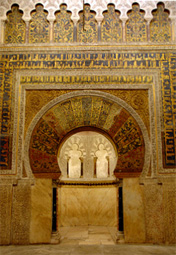La segunda ampliación (siglo X)
 When Abderraman III was proclaimed Caliph in 929, Cordoba grew to become the largest and most influential city in the whole of the western Islamic world. The only reforms to the Mosque which date from this period are the new minaret (which was the first of its kind in the west) and the enlargement of the courtyard. Abderraman was forced to strengthen the arches which connected the covered area with the ablutions courtyard, as they had weakened from the weight of the naves. Over the main entrance to the mosque, coming from the courtyard, he built a great horseshoe arch over the existing one, with a barrel vault between the two. Later that century, Caliph Alhaken II did a lot to encourage culture and develop the areas of aesthetic and literary art. At the same time, more and more political and cultural contacts were established with the great eastern capital of Byzantium.
When Abderraman III was proclaimed Caliph in 929, Cordoba grew to become the largest and most influential city in the whole of the western Islamic world. The only reforms to the Mosque which date from this period are the new minaret (which was the first of its kind in the west) and the enlargement of the courtyard. Abderraman was forced to strengthen the arches which connected the covered area with the ablutions courtyard, as they had weakened from the weight of the naves. Over the main entrance to the mosque, coming from the courtyard, he built a great horseshoe arch over the existing one, with a barrel vault between the two. Later that century, Caliph Alhaken II did a lot to encourage culture and develop the areas of aesthetic and literary art. At the same time, more and more political and cultural contacts were established with the great eastern capital of Byzantium.
Alhaken II added twelve more naves, taking the Mosque even closer to the banks of the river Guadalquivir and reaching the size which remains to this day. All the materials this time were made specially for the building. Alternate columns of red and blue marble were used, and the purpose-built capitals, which were a schematized version of classical models, featured the so-called pencas (leaf shapes). In the qibla or end wall of the building, lies the mihrab or niche for the prayer-leader. This wall was built double to support the great weight resting on it, making the building doubly solid. In the side of this wall lies the main focal point of the whole Mosque : the maqsura, or space facing the mihrab. A series of vaults, on which oil lamps were hung, were built above this area to make up for the lack of natural light and illuminate the most important part of the Mosque.
The vaults are made up of large, thick ribs with open spaces between them. This building technique was used much later in Mudejar art, where it was called Caliphal ribbed vaulting. The maqsura was embellished with sculpted marble plinths with Syrian designs, and with mosaics made up of glass pieces (tesserae), in the same special colours used in a lot of Byzantine decorative work. The inside of the mihrab is octagonal, covered by a stylish cupola in the shape of a scallop-shell.